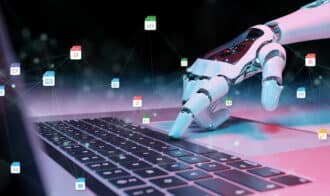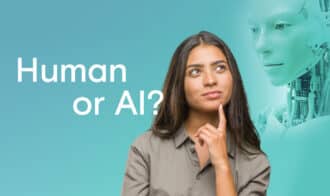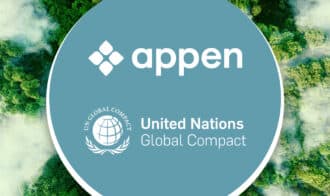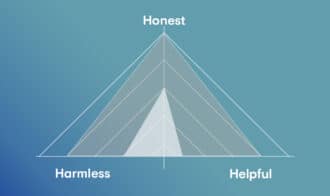How did you use artificial intelligence today? If you think you haven’t, think again. AI is already powering so many of our everyday activities, and though you may not be intentionally leveraging it as a tool just yet, that’s likely to change in the very near future. The AI race is just getting started, as top tech companies build and improve their own large language models (LLM). Microsoft launched its own Bing AI chatbot last month, Google’s ‘Bard’ was released in March of this year, and we can’t forget about OpenAI’s ChatGPT.
Though a prominent current events topic, creating the best large language model isn’t the only race within the world of AI. AI has become a fixture in the healthcare, environmental conservation, education, and agriculture industries and it’s rapidly transforming our everyday lives for the better!
Embracing AI offers benefits such as enhanced efficiency, improved decision-making, and accelerating scientific progress. It can help solve complex global challenges such as climate change, resource management, and disease control.
Not convinced? Let’s discuss.
Transforming Healthcare with AI: The Potential of AI Applications in the Medical Field
What if you could refill your prescription or schedule an appointment with your doctor using a virtual voice assistant? Using a chat response assistant could become a new norm in the future of our healthcare services.
The University of Pennsylvania Health System recently tested ‘Penny,’ an AI chatbot, to help improve cancer care in patients taking oral chemotherapy. This augmented intelligence chatbot employs text-based conversational interactions to effectively support patients in navigating complex treatment regimens and minimize the risk of potential errors during their chemotherapy journey.
AI algorithms can also analyze copious amounts of medical data, including patient records and medical images, to detect patterns and supply insights for exact diagnoses. Hospitals in Hungary have been using AI since 2021 to detect breast cancer that doctors might otherwise miss. Of course, a lot of testing and clinical trials come with any innovative technology implementation, but even in its testing stages, technologists and medical professionals are optimistic about the potential to improve healthcare outcomes and create more efficient resource allocation.
Another innovative health tool that’s still in the works is Google’s new DermAssist search app. It’s going to revolutionize skincare support! Users will be able to submit information about their skin by uploading three photos of their skin condition and answering a few questions from their phone or computer. Leveraging its extensive database of millions of skin-related images, DermAssist analyzes the submitted photos and information to identify potential skin conditions. Within a minute, users receive a comprehensive list of possible matching skin conditions, accompanied by valuable information about each one.
It’s important to note that DermAssist is specifically designed for individuals aged 16 and older who are seeking skincare information and guidance, rather than a medical diagnosis. DermAssist is currently not available in the United States and not FDA-approved.
Harnessing the Power of AI: Innovations in Environmental Conservation through Artificial Intelligence Solutions
With the aid of current AI-powered systems, we have been able to monitor and manage environmental resources to mitigate the risks associated with natural disasters. At the moment, this is crucial due to the depletion of our natural resources and the rampant effects of climate change. An example of its application is analyzing satellite imagery to track deforestation, monitor wildlife populations, observe environmental conditions, and predict natural disasters.
The European Space Agency applies AI to analyze satellite data, enabling the monitoring of air pollution levels in urban areas. By supplying in-depth information on pollution sources, this system aids policymakers in devising precise strategies to effectively mitigate pollution and reduce its impact.
Another recent use of AI comes from the National Oceanic and Atmospheric Administration (NOAA). By meticulously analyzing satellite data and sensor readings, their advanced system generates highly precise models of hurricane behavior. This information can help predict natural disasters which can potentially issue warnings and evacuate people on time. Thanks to AI, this groundbreaking technology enables emergency responders to better expect and respond to hurricanes.
The Future of Education: The Transformative Impact of Artificial Intelligence in Teaching and Learning
Ever since ChatGPT became publicly available, there’s been a lot of discussion about how it would affect educational institutions and students. Should students be allowed to use generative AI applications at school?
In a recent TED Talk, Sal Khan, the visionary behind Khan Academy, a nonprofit organization dedicated to providing free educational resources, discussed how AI can revolutionize education by offering personalized tutoring. To prove his point, he showcased a chatbot named Khanmigo, developed by his organization, which offers invaluable assistance in various subjects like math, computer science, and writing.
The launch of Khanmigo in March marked a significant milestone as it initiated a pilot program involving over 500 public school districts and schools, inviting them to test the chatbot and contribute feedback. Distinct from merely providing answers, Khanmigo, powered by GPT-4, guides users in effectively solving problems, fostering a deeper understanding of the subject matter.
This is monumental in the educational space because not only would students be tackling difficult subjects like math with their own personal AI tutor, but it can also assist students with learning disabilities. AI tutors can employ various multimedia formats such as visual aids, audio instructions, and interactive elements to engage students with different learning disabilities. By presenting information in multiple modalities, AI tutors can enhance comprehension and retention for students with diverse learning needs.
The AI + Education Summit at Stanford University held a conference this year and broke down the benefits and risks of using AI in classrooms. Some of the benefits highlighted were:
- Real-time feedback and teaching suggestions
- Enhanced personalized support
- Improved learning, and assessment quality
- Improved learners’ self-confidence
- Refreshing expertise for teachers
Generative AI enhances and optimizes learning outcomes by actively providing teachers with feedback based on professional pedagogy. It also provides equal access to quality education for students in various locations or with varying learning abilities.
Of course, a few concerns were addressed as well. Generative AI has yet to pick up text in language for a diverse population, sometimes generates incorrect responses, and can cause a motivation crisis in humans. For instance, we’ve all heard stories about AI taking jobs from humans. These jobs vary from writing to coding or even taking drive-thru orders. If students feel like hard earned skills aren’t valuable, wouldn’t that cause a lack of motivation to pursue an educational journey?
Despite these challenges, AI technology is advancing quickly and it’s transforming our everyday lives. That’s why it’s important to implement it into these different sectors in a thoughtful and efficient manner.
Smart Farming with AI: Artificial Intelligence in Agricultural Practices for Higher Yields and Resource Optimization
Agribots are the new normal in the agriculture business! Other AI systems will be too as this industry and its advancements continue to evolve rapidly. By adding AI in agriculture, we can see improvement in resource management, sustainable farming practices, increased productivity, and reduced environmental impact. It can also help with food security, sustainability, and supporting farmers’ livelihoods.
The AI evolution of farming practices is actively improving crop monitoring and disease detection, harvesting automation, and predictive analysis. Software like Farmwave uses machine learning algorithms and high-resolution cameras to check crop health and find diseases. Early detection allows for targeted interventions, minimizing crop losses and reducing the need for broad-spectrum treatments.
Agribots and machines can also autonomously harvest crops by using computer vision to find ripe fruits or vegetables, reducing labor costs and improving efficiency. AI-powered agriculture analytics harnesses the power of AI algorithms to analyze historical data, weather patterns, market trends, and various factors, providing valuable insights and predictions for optimized planting schedules, yield forecasts, and market demand projections.
At Appen, we firmly believe in the potential of AI to tackle the world’s most pressing issues. Our unwavering commitment to developing and implementing AI ethically and responsibly ensures that everyone benefits from its transformative power. With a global community of over one million diverse individuals, we are dedicated to creating AI solutions that are not only relevant but also trustworthy and truthful.
By working together, we are actively shaping the future of AI and empowering businesses, governments, and communities to generate meaningful change in society. Appen’s AI for good leverages this technology for the betterment of humanity, amplifying its positive impact and enabling a brighter future for all.
As AI continues to advance, it’s crucial to address ethical concerns, ensure data privacy, promote transparency, and accountability in its implementation. Additionally, ongoing research, testing, and collaboration between technology companies, policymakers, and society at large will be vital in harnessing the full potential of AI. With responsible and ethical use, AI can create a future where healthcare is more accessible, the environment is better protected, education is personalized and inclusive, and agriculture is sustainable and efficient. Embracing the transformative power of AI will pave the way for a brighter and more prosperous future for all.











